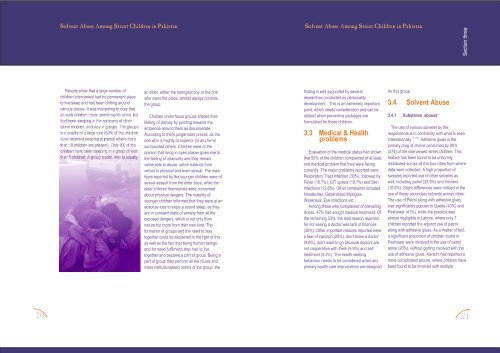solvent-abuse-pakistan
solvent-abuse-pakistan
solvent-abuse-pakistan
Create successful ePaper yourself
Turn your PDF publications into a flip-book with our unique Google optimized e-Paper software.
Section three<br />
Results show that a large number of<br />
children interviewed had no permanent place<br />
to live/sleep and had been drifting around<br />
various places. It was interesting to note that<br />
all such children never spend nights alone, but<br />
had been sleeping in the company of other<br />
street children, and stay in groups. The groups<br />
are usually of a large size (60% of the children<br />
have reported sleeping at places where more<br />
than 10 children are present). Only 8% of the<br />
children have been sleeping in a group of less<br />
than 5 children. A group leader, who is usually<br />
an elder, either the strongest boy or the one<br />
who owns the place, almost always controls<br />
the group.<br />
Children under focus groups shared their<br />
feeling of dismay by pointing towards the<br />
ambience around them as disconsolate.<br />
According to them jungle rules prevail, as the<br />
one who is mighty or superior (in any form)<br />
surmounted others. Children were of the<br />
opinion that living in open places gives rise to<br />
the feeling of insecurity and they remain<br />
vulnerable to <strong>abuse</strong>, which extends from<br />
verbal to physical and even sexual. The main<br />
fears reported by the younger children were of<br />
sexual assault from the elder boys, while the<br />
elder children themselves were concerned<br />
about physical dangers. The majority of<br />
younger children informed that they were at an<br />
absolute loss to enjoy a sound sleep, as they<br />
are in constant state of anxiety from all the<br />
exposed dangers, which is not only from<br />
nature but more from their own kind. The<br />
formation of groups and the need to stay<br />
together could be explained in the light of this<br />
as well as the fact that being human beings,<br />
and for need fulfilment, they had to live<br />
together and became a part of group. Being a<br />
part of group they perform all the rituals and<br />
meet institutionalised norms of the group; the<br />
finding is well supported by several<br />
researches conducted on personality<br />
,<br />
development . This is an extremely important<br />
point, which needs consideration and can be<br />
utilized when preventive packages are<br />
formulated for these children.<br />
3.3 Medical & Health<br />
problems<br />
Evaluation of the medical status had shown<br />
that 55% of the children complained of at least<br />
one medical problem that they were facing<br />
currently. The major problems reported were<br />
Respiratory Tract Infection (30%), followed by<br />
Fever (19.7%), GIT upsets (18.7%) and Skin<br />
Infections (12.6%). Other complaints included<br />
Headaches, Generalized Myalgias,<br />
Weakness, Eye Infections etc.<br />
Among those who complained of prevailing<br />
illness, 47% had sought medical treatment. Of<br />
the remaining 53%, the lead reason reported<br />
for not seeing a doctor was lack of finances<br />
(39%). Other important reasons reported were<br />
a fear of injection (20%), don't know a doctor<br />
(9.8%), don't want to go because doctors are<br />
not cooperative with them (9.9%) and self<br />
treatment (3.3%). The health seeking<br />
behaviour needs to be considered when any<br />
primary health care interventions are designed<br />
for this group.<br />
3.4 Solvent Abuse<br />
3.4.1 Substance <strong>abuse</strong>d<br />
The use of various <strong>solvent</strong>s by the<br />
respondents is in conformity with what is seen<br />
12-14,17<br />
internationally. Adhesive glues is the<br />
primary drug of choice consumed by 90%<br />
(374) of the interviewed street children. This<br />
feature has been found to be uniformly<br />
distributed across all the four cities from where<br />
data were collected. A high proportion of<br />
samples reported use of other <strong>solvent</strong>s as<br />
well, including petrol (25.5%) and thinners<br />
(10.6%). Slight differences were noticed in the<br />
use of these secondary <strong>solvent</strong>s across cities.<br />
The use of Petrol along with adhesive glues<br />
was significantly popular in Quetta (43%) and<br />
Peshawar (41%), while the practice was<br />
almost negligible in Lahore, where only 7<br />
children reported the adjunct use of petrol<br />
along with adhesive glues. As a matter of fact,<br />
a significant proportion of children found in<br />
Peshawar were involved in the use of petrol<br />
alone (26%), without getting involved with the<br />
use of adhesive glues. Karachi has reported a<br />
more complicated picture, where children have<br />
been found to be involved with multiple<br />
20<br />
21


